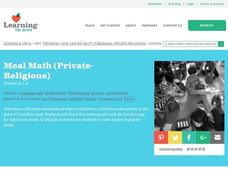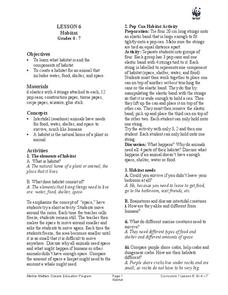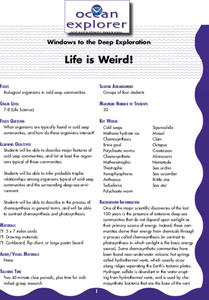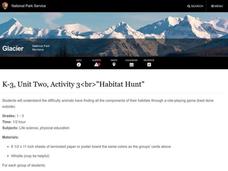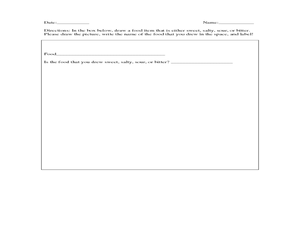Curated OER
Goods and Services
Second graders demonstrate their understanding of goods and services through group presentation. In this simplified economics lesson plan, 2nd graders are divided into groups representing a particular market. They then create posters...
Curated OER
Hunger/ Nutrition
Seventh graders investigate nutrients and nutrition to determine what types of food the body needs for energy. They study each type of nutrient and why it is important to the body. They determine what a balanced diet is by completing the...
Curated OER
Tzedakah: How Can We Help?
Students identify nutritious meals and the prices of a healthy meal. In this nutritious meals lesson, students work in small groups and plan a menu for a nutritious meal. Students figure the total cost of the meal and collect money to...
Curated OER
Habitat
Students explore the attributes of animal habitats. In this habitat lesson, students examine animal habitats as they conduct a scientific investigation to create an animal habitat that provides food, shelter, and space.
Curated OER
Ecology
Fourth graders research an ecosystem and its endangered species. They create a PowerPoint Presentation, oral report, poster or a booklet based on their research. They research on the internet and in biology texts in teams of 4.
Curated OER
Purchasing Power
Learners participate in a lemonade sale and record their sales in a journal. For this fundraising lesson, students donate money they have raised from a lemonade sale and make a plan for how the money should be spent.
Curated OER
Healthy Island
Students engage in an activity that integrates nutrition information with upper body strengthening physical activities.
Curated OER
Uses of a Tree
Students complete a word sort to discover the relationship of tree resources. In this tree resource lesson, students examine information from the word sort and the book "Be a Friend to Trees" by Patricia Lauber. Finally, students create...
Curated OER
Life is Weird!
Students describe major features of cold seep communities, and list at least five organisms typical of these communities. They infer probable trophic relationships among organisms typical of cold-seep communities and the surrounding...
Curated OER
The Magic School Bus Baked in a Cake
Students learn along with Ms. Frizzle's class. In this Magic School Bus lesson plan, students learn that baking is like a chemistry experiment as they make chemistry happen by following a recipe for pretzels.
Curated OER
Gourmet Chef or Fast Food Mama?
Students examine the contents of a 17th century women's kitchen. Using probate records, they compare them with a historian's record of the same event. They complete an inventory of a kitchen of a women in their own lives.
Curated OER
Discovering Adjectives
Young scholars work in groups to discover and practice using adjectives. They use food items for the activity and compete with other groups on who can have the most adjectives. They may use other materials in the room as well.
Curated OER
NickNews: Winners and Losers
Students view the excerpt from NickNews entitled, "Winners and Losers." In groups, they categorize a variety of words and images relating to weight, healthy eating, and healthy lifestyle. They discuss adopting positive eating habits,...
Curated OER
Depression Nutrition Plan
Students plan meals for a day based on their own caloric needs, make a shopping list, and "shop" on line. In this Great Depression nutrition plan instructional activity, students calculate their caloric needs and plan meals before...
Curated OER
Estuaries, Estuarine Habitats, and Adaptations
Middle schoolers conduct research on estuaries. They design and construct an estuary, describe the physical characteristics of an estuary, and create a diagram illustrating an estuarine food web.
Curated OER
Calorie Countdown
Students identify the advantages of a healthy diet and exercise plan. In this health activity, students bring in labels of different food products and calculate the amount of calories each serving is. Students keep a food diary to keep...
Curated OER
Habitat Hunt
Learners discover how hard it is for animals to find all the items needed in their habitat. In this habitat lesson, students play a game in which they pretend to be an animal, they discover that not all animals can find the food needed...
Curated OER
Headlines of the Past
Young scholars study the lives of four Native cultures. They examine the people that inhabited Wisconsin over the last 12,000 years. They create a newspaper and imagine themselves as a reporter living during this time period and sharing...
Curated OER
Fractions in Shapes
First graders explore fractions with manipulatives. In this fraction lesson, 1st graders use paper foods such as sandwiches and pizza in order to find halves, thirds, fourths, eighths, and more. This lesson is divided up into 3 tiers...
Curated OER
Terrific Taste Buds
Learners explore descriptive writing by eating food in class. In this descriptive word lesson, students assess different foods in class such as jelly beans and utilize their vocabulary to describe the taste. Learners read the story...
Curated OER
American Chestnut
Students discuss importance of American Chestnut tree, explore its value and uses, examine how it has almost become extinct, and identify ways certain groups are working to help regain American Chestnut tree population through breeding.
Curated OER
Health: Basic Minerals
Students examine minerals as food nutrients and discover their importance as food sources in the diet. Among the learning options are completing worksheets, creating recipes, making billboards, and actually preparing some recipes rich...
Curated OER
Away we Go
Students work in groups to calculate the costs of a trip to Six Flags amusement park. In this domain and range lesson, students calculate the least and greatest amounts of money needed for tickets, food, souvenirs, and airplane tickets.
Curated OER
Cooking Lesson
Fourth graders taste different flavors on their popcorn. In this taste bud lesson, 4th graders make predictions about taste and dip popcorn into four different flavors. They record how the flavors tasted - sweet, salty, bitter, or sour.




